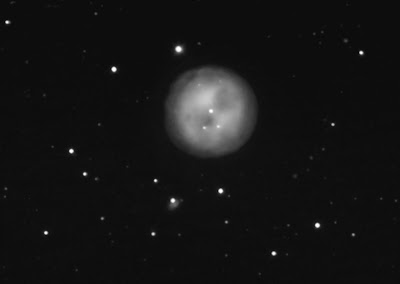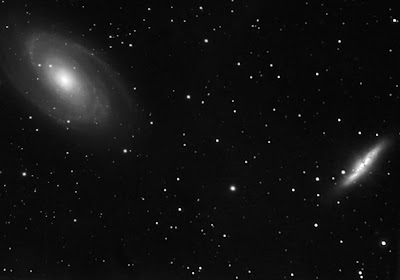 Click on image to enlarge.
Click on image to enlarge.Object: Messier 97 (NGC 3587)
Type: Planetary Nebula
Distance: 2600 light years
Distance: 2600 light years
Constellation: Ursa Major
Date: 25 March 2009
Equipment: SXV-H9, Vixen VC200L 200mm aperture f9 catadioptic, UV/IR filter
Subframes: 17 x 120 seconds (3x3 binned), 16 flats/flat darks, calibrated and stacked in AIP4Win, tweaked in AstroArt and PSP7.
Another clear but very windy night. I had previously used my 200mm Vixen 'scope to visually examine and sketch this object about five years ago. It was a stunningly dark and clear spring night, and the memory of being able to clearly see the "Owl's eyes" has stayed with me ever since then.
Such nights are a rarity in my little light-polluted corner of the world, and this plainly wasn't one of them. Try as I might, I couldn't even see the Owl at all. Indeed, I even had to resort to 3x3 binning to get a image I could see on screen via my CCD.
At a focal length of 1800mm, even my Vixen GPDX won't allow more than a couple of minutes unguided exposures. I have given up on trying to get my SXV-H9 autoguider to work. Despite some very helpful dialogue on the Starlight Xpress board, it's still no go. I thought my wiring was wrong but I've tried the cable with someone else's SS2K and it works. Clearly the fault is with my SS2K handset or the SXV itself - I need to check out my handset with my colleague's set-up...
Anyway, I spent about 30 minutes doing a drift alignment to get the tracking spot on. I usually shoot two minute frames and tweak the mount Alt/Az controls until no trailing is apparent. On this evening, the gusty wind was giving me all sorts of problems with both this and the PEC setting.
In the end, I got something I thought was about right, and went for 50x2 minute exposures at 3x3 binning - the image was so faint I reckoned the extra sensitivity would outweigh loss of detail, especially given the long focal length.
Needless to say, clouds rolled on halfway through the session. I got 37 subs in all, of which only 17 were usable thanks to the gusting wind. So I'm actually quite pleased with the result given the conditions and lack of subs, an image which shows the Owl's eyes reasonably well.
On my image I noticed a smudge of what seems to be nebulosity under the star (GSC catalog number GSC-3824-1065 I think, according to SkpMap Pro 9) just beneath the nebula at the 7 o' clock position. I initially thought that this was a processing artifact, but Johannes Schedler's much better resolved shot shows it as well. SkyMap Pro 9 doesn't show it - there's a galaxy (PGC 34279) indicated nearby, but not quite in the same position
Does anybody know if this star's beard has a designation?
Update: The helpful and knowledgeable folk on the SPA gallery forum have confirmed that my "mystery nebula" is indeed the 16th magnitude galaxy PCG 34279. It prompted me to have a play with using the SLOAN digital sky survey, which is an amazing resource to use. Click on the above link to the forum to see the discussion and links to the SDSS data.
Equipment: SXV-H9, Vixen VC200L 200mm aperture f9 catadioptic, UV/IR filter
Subframes: 17 x 120 seconds (3x3 binned), 16 flats/flat darks, calibrated and stacked in AIP4Win, tweaked in AstroArt and PSP7.
Another clear but very windy night. I had previously used my 200mm Vixen 'scope to visually examine and sketch this object about five years ago. It was a stunningly dark and clear spring night, and the memory of being able to clearly see the "Owl's eyes" has stayed with me ever since then.
Such nights are a rarity in my little light-polluted corner of the world, and this plainly wasn't one of them. Try as I might, I couldn't even see the Owl at all. Indeed, I even had to resort to 3x3 binning to get a image I could see on screen via my CCD.
At a focal length of 1800mm, even my Vixen GPDX won't allow more than a couple of minutes unguided exposures. I have given up on trying to get my SXV-H9 autoguider to work. Despite some very helpful dialogue on the Starlight Xpress board, it's still no go. I thought my wiring was wrong but I've tried the cable with someone else's SS2K and it works. Clearly the fault is with my SS2K handset or the SXV itself - I need to check out my handset with my colleague's set-up...
Anyway, I spent about 30 minutes doing a drift alignment to get the tracking spot on. I usually shoot two minute frames and tweak the mount Alt/Az controls until no trailing is apparent. On this evening, the gusty wind was giving me all sorts of problems with both this and the PEC setting.
In the end, I got something I thought was about right, and went for 50x2 minute exposures at 3x3 binning - the image was so faint I reckoned the extra sensitivity would outweigh loss of detail, especially given the long focal length.
Needless to say, clouds rolled on halfway through the session. I got 37 subs in all, of which only 17 were usable thanks to the gusting wind. So I'm actually quite pleased with the result given the conditions and lack of subs, an image which shows the Owl's eyes reasonably well.
On my image I noticed a smudge of what seems to be nebulosity under the star (GSC catalog number GSC-3824-1065 I think, according to SkpMap Pro 9) just beneath the nebula at the 7 o' clock position. I initially thought that this was a processing artifact, but Johannes Schedler's much better resolved shot shows it as well. SkyMap Pro 9 doesn't show it - there's a galaxy (PGC 34279) indicated nearby, but not quite in the same position
Does anybody know if this star's beard has a designation?
Update: The helpful and knowledgeable folk on the SPA gallery forum have confirmed that my "mystery nebula" is indeed the 16th magnitude galaxy PCG 34279. It prompted me to have a play with using the SLOAN digital sky survey, which is an amazing resource to use. Click on the above link to the forum to see the discussion and links to the SDSS data.



